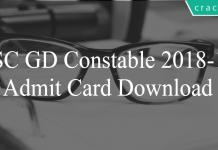Download Syllogism Questions Set-2 PDF
Instructions
In each of the following questions below are given three statements followed by three conclusions numbered I, II, III. You have to take the given statements to be true even if they seem to be at variance from commonly known facts. Read all the conclusions and then decide which of the given conclusion logically follows from the given statements disregarding commonly known facts
Question 1: Statements:
Some flowers are bins.
Some bins are handles
All handles are sticks
Conclusion:
I: Some sticks are bins.
II: Some handles are flowers.
III: Some sticks are flowers.
a) Only II follows
b) Only III follows
c) Only I and II follows
d) Only I and III follows
e) None of these
Question 2: Statements:
Some towers are windows.
All windows are houses.
Some houses are temples.
Conclusions:
I: Some towers are temples.
II: some houses are towers.
III: Some temples are windows.
a) Only I follows
b) Only II follows
c) Only III follows
d) Only I and II follows
e) None of these
Question 3: Statements:
Some walls are doors.
Some doors are cots.
Some cots are chairs.
Conclusions:
I: Some chairs are doors.
II: Some cots are walls.
III: No chair is door
a) Only II follows
b) Only III follows
c) Only either I or III follows
d) Only I follows
e) None of these
Free Banking Study Material – 15000 Solved Questions
Question 4: Statements:
All trees are garden.
All gardens are stones.
All stones are fences.
Conclusion:
I: Some fences are gardens.
II: All gardens are fences.
III: Some stones are trees.
a) Only I and II follows
b) Only I and III follows
c) Only II and III follows
d) All follows
e) None of these
Question 5: Statements:
All books are leaves.
Some leaves are jungles
No jungles is box
Conclusions:
I: Some jungles are books.
II: No book is box.
III: Some leaves are boxes
a) None follows
b) Only I follows
c) Only II follows
d) Only III follows
e) Only I and II follows
Instructions
In each question below are given two/three statements followed by two conclusion numbered I and II.You have to take the given statements to be true even if they seem to be at variance with commonly known fact.Read all the conclusions and then decide which of the given conclusion logically follows from the given statement disregarding commonly know facts.Give answer.
Question 6: Statements: All rings are circles.
All square are are rings.
No ellipse is a circle.
Conclusions:I. Some rings being ellipses is a possibility.
II. At least some circles are squares.
a) if only conclusion I follows.
b) if only conclusion II follows.
c) if either conclusion I or conclusion II follows.
d) if neither conclusion I nor conclusion II follows.
e) if both conclusion I and conclusion II follows.
Question 7: Statements: No house is an apartment.
Some bungalows are apartments.
Conclusions:I.No house is a bungalow.
II.All bungalows are houses.
a) if only conclusion I follows.
b) if only conclusion II follows.
c) if either conclusion I or conclusion II follows.
d) if neither conclusion I nor conclusion II follows.
e) if both conclusion I and conclusion II follows.
Question 8: Statements:Some gases are liquids
All liquids are water.
Conclusions:I.All gases being water is a possibility.
II.All such gases which are not water can never be liquids.
a) if only conclusion I follows.
b) if only conclusion II follows.
c) if either conclusion I or conclusion II follows.
d) if neither conclusion I nor conclusion II follows.
e) if both conclusion I and conclusion II follows.
Question 9: Statements :
All seconds are hours.
No second is a day
Conclusions :
I. No day is an hour.
II. At least some hours are seconds
a) if only conclusion I follows.
b) if only conclusion II follows.
c) if either conclusion I or conclusion II follows.
d) if neither conclusion I nor conclusion II follows.
e) if both conclusion I and conclusion II follows.
Question 10: Statements:Some teachers are professors.
Some lecturers are teachers.
Conclusions:I.All teachers as well as professors being lectures is a possibility.
II.All those teachers who are lectures are also professors.
a) if only conclusion I follows.
b) if only conclusion II follows.
c) if either conclusion I or conclusion II follows.
d) if neither conclusion I nor conclusion II follows.
e) if both conclusion I and conclusion II follows.
Question 11: Statements:Some teacher are professors.
Some lecturers are teachers.
Conclusions:I.No professor is a lecture.
II.All lectures being professors is a possibility.
a) if only conclusion I follows.
b) if only conclusion II follows.
c) if either conclusion I or conclusion II follows.
d) if neither conclusion I nor conclusion II follows.
e) if both conclusion I and conclusion II follows.
Instructions
In each question below are two statements followed by two conclusions numbered I and II. You have to take the two given statements to be true even if they seem to be at variance from commonly known facts and then decide which of the given conclusions logically follows from the given statements disregarding commonly known facts.
Give answer
Question 12: ‘’Statements’’ some trees are bushes. All flowers are bushes.
Conclusions: I. Atleast some bushes are trees.
II. Atleast some flowers are tress.
a) only Conclusion I follows
b) only Conclusion II follows
c) either Conclusion I or II follows
d) neither Conclusion I nor II follows
e) both Conclusions I and II follow
200+ Banking Previous Papers (Download PDF)
Question 13: ‘’Statements’’ All colours are paints. No paint is a brush.
Conclusions: I. Atleast some brushes are colours.
II. No brush is a colour
a) only Conclusion I follows
b) only Conclusion II follows
c) either Conclusion I or II follows
d) neither Conclusion I nor II follows
e) both Conclusions I and II follow
Question 14: ‘’Statements’’ Some chemicals are organics. All organics are fertilizers.
Conclusions: I. Atleast some fertilizers are chemicals.
II. All fertilizers are organics.
a) only Conclusion I follows
b) only Conclusion II follows
c) either Conclusion I or II follows
d) neither Conclusion I nor II follows
e) both Conclusions I and II follow
Question 15: ‘’Statements’’ No air is solid. Some solids are liquids.
Conclusions: I. No liquid is air
II. Some airs are definitely not liquids.
a) only Conclusion I follows
b) only Conclusion II follows
c) either Conclusion I or II follows
d) neither Conclusion I nor II follows
e) both Conclusions I and II follow
Free Banking Study Material (15000 Solved Questions)
Answers & Solutions:
1) Answer (E)
The syllogism can be better explained with the help of a Venn diagram.
Some sticks are bins. This conclusion is true
Some handles are flowers. This conclusion, apparent from Venn diagram, does not follow.
Some sticks are flowers. The sets of sticks and flowers are disjoint as apparent from Venn diagram. Hence, this conclusion does not follow.
2) Answer (B)
The syllogism can be explained with following Venn Diagram.
Some towers are temples. This conclusion cannot be made.
Some houses are towers. This conclusion is true.
Some temples are windows. This conclusion again cannot be made with surety.
Only II follows.
3) Answer (C)
The syllogisms can be intrepreted as:
Some chairs are doors. We cannot make this conclusion.
Some cots are walls. We also cannot makes this conclusion as both them are disjoint sets.
No chair is door. This conclusion is true and follows.
4) Answer (D)
The given information can be intrepreted in Venn diagram form as:
Here, if we assume – trees, gardens, stones and fences as sets then
Tree is subset of gardens. Gardens is subset of stones. Stones is subset of fences.
Therefore, all the conclusions are true.
Option D is correct answer.
5) Answer (A)
The syllogism can be intrepreted in Venn Diagram form as:
Some jungles are books. This can’t be said with surety.
No book is box. This also cannot be concluded with any assurance.
Some leaves are boxes. The defibnite position of box set with respect to other sets is not known.
Hence, none of the conclusion follow.
6) Answer (B)
ll rings are circles. Some circles are rings.
All square are are rings. Hence, some squares must be circles. Since no circle is an ellipse, no ring can be ellipse.
This can be seen from the following venn diagram.

Only statement II follows.
7) Answer (D)
No house is an apartment.
Some bungalows are apartments. We cannot establish a relationship between bungalows.
Neither of I and II follow.
Therefore, option D is correct.
8) Answer (A)
Some gases are liquids. All liquids might be gases.
All liquids are water. Hence, all liquids might be water.
Therefore, only statement I follows.
Option A is correct answer.
9) Answer (B)
The venn diagram for above statements is :

Conclusions :
I. No day is an hour = false
II. At least some hours are seconds = true
Thus, only conclusion II follows.
=> Ans – (B)
10) Answer (A)
Some teachers are professors. All professors might be teachers.
Some lecturers are teachers. All teachers might be lecturers. Hence, all professors might be lecturers.
Therefore only statement I follows.
Option A is correct.
11) Answer (B)
Some teachers are professors. All professors might be teachers.
Some lecturers are teachers. All teachers might be lecturers. All lecturers might professors.
Therefore only statement II follows.
Option A is correct.
12) Answer (A)
The data can be intrepreted in Venn diagram form as:
Conclusions: I. Atleast some bushes are trees. This is a true conclusion as apparent from Venn diagram.
II. Atleast some flowers are tress. This cannot be conluded with surety.
Only I follows.
13) Answer (B)
The data can be intrepreted in Venn diagram form as:
Conclusions: I. Atleast some brushes are colours.
II. No brush is a colour. This statement is true.
14) Answer (A)
The data can be intrepreted in Venn diagram form as:
Conclusions: I. Atleast some fertilizers are chemicals. This is a true conclusion as apparent from Venn diagram.
II. All fertilizers are organics.This is incorrect conclusion.
Only I follows.
15) Answer (C)
The given data can be intrepreted in Venn diagram form as:
Conclusions: I. No liquid is air.
II. Some airs are definitely not liquids. Statements I and II form universal set and one of them is true.
Either I or II is true.





